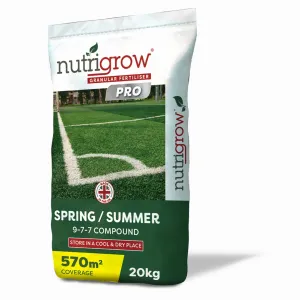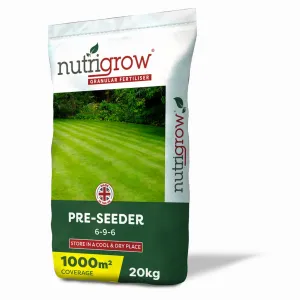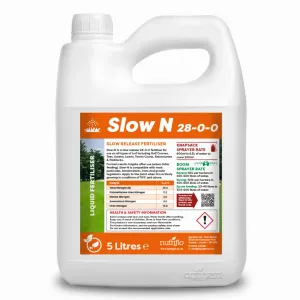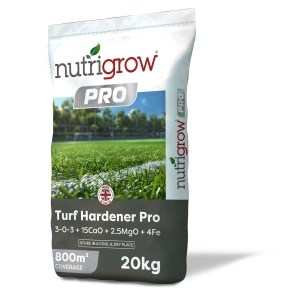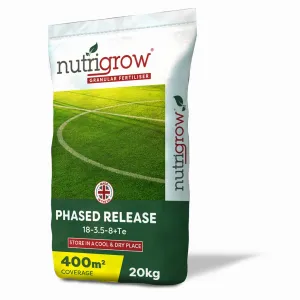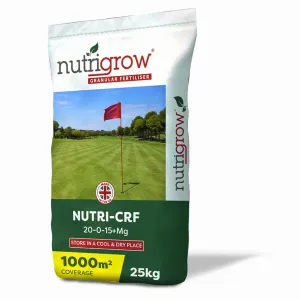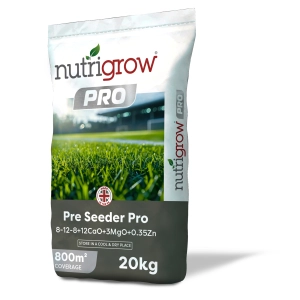Fertilisers are labelled with an N-P-K ratio, which stands for:
- N = Nitrogen – promotes lush, green leaf growth.
- P = Phosphorus – supports strong root development.
- K = Potassium – enhances overall plant health and disease resistance.
For example, a fertiliser labelled 9-7-7 contains:
- 9% Nitrogen
- 7% Phosphorus
- 7% Potassium
These three nutrients are referred to as primary nutrients or macronutrients. There are other macronutrients including:
- Magnesium (Mg) – Essential for chlorophyll production; deepens green colour.
- Calcium (Ca) – Strengthens cell walls and supports root health.
- Sulphur (S) – Helps plants metabolise nitrogen efficiently.
But there are also many secondary nutrients or micronutrients contained in some lawn fertilisers – in various ratios depending on function.
These are often included in smaller amounts but are still vital. They include:
- Iron (Fe) – Promotes deep green colour and is often used to control moss.
- Manganese (Mn) – Supports photosynthesis and enzyme function
Why Fertiliser Ratios Vary
The NPK ratio / analysis is based on several factors but can include:
Seasonal Needs:
- Spring/Summer: High nitrogen (e.g., 10-4-4) for vigorous growth.
- Autumn/Winter: Low nitrogen, higher potassium (e.g., 4-2-16) to harden turf.
Lawn Condition:
- New Lawns: Higher phosphorus (e.g., 10-15-10) to support root establishment.
- Stressed Lawns: Higher potassium to improve resilience.
Soil Type & Nutrient Deficiency:
- Soil tests can reveal deficiencies, guiding the choice of fertiliser.
- Sandy soils may leach nutrients faster, requiring more frequent feeding
Lawn Use:
- High-traffic areas (e.g., sports fields) may need more nitrogen for recovery.
- Shaded or ornamental lawns may benefit from balanced or lower-nitrogen blends.
Common Lawn Fertiliser Ratios and Their Uses
So, we know we have macro and micronutrients and that their ratios depend on a variety of lawn needs, soil types, and seasons. What does that look like in reality? Here are some of our most popular fertiliser products with their ratios and what our customers buy them for.
| Product | N-P-K Ratio | Best For |
| Nutrigrow Spring/Summer Blend | 9-7-7 | General spring/summer feeding |
| Nutrigrow Autumn Fertiliser | 3-12-12 | Strengthening roots before winter |
| Nutrigrow Pre-Seeder | 6-9-6 | Preparing soil before seeding |
| Nutrigrow MossTop | 6-5-10 + Fe | Hardening grass off for winter |
| Slow N Liquid Fertiliser | 28-0-0 | High nitrogen boost for rapid green-up |
Specialist Fertiliser Ratios and Their uses
We also stock specialist blends of turf fertiliser, primarily used by professional grounds keepers looking to get more from their turf, especially sports turf. But these ratios can be used by home gardeners who have specific needs or are looking for more performance from their lawn grass.
Here are a few examples of professional-use fertilisers and their nutrient ratios; notice the introduction of more targeted micronutrient ratios:
| Product | N-P-K Ratio | Best For |
| Nutrigrow Turf Tonic Pro | 9-0-0+4CaO+11Fe | Helps grass recover from stress |
| Nutrigrow Turf Hardener Pro | 3-0-3+15CaO+2.5MgO+4Fe | Hardens turf off pre-Winter |
| Nutrigrow Phased Release | 18-3.5-8+1Mg | Phased release to avoid rapid growth and scorching |
| NutriCRF | 20-0-15 + 2MgO | For continued but slow growth through the cooler months |
| Nutrigrow Pre Seeder Pro | 8-12-8+12CaO+3MgO+0.35Zn | Enhancing soil health and nutrient uptake before seeding |
Now you’re ready to select a lawn fertiliser ratio that matches your personal lawn needs and desired outcomes. But how much do you need to buy and apply?
Measure Your Lawn Size
To understand how much lawn fertiliser you need to buy, you will need to know how big your lawn is. Here’s how to measure your lawn accurately:
- For square or rectangular lawns: Multiply the length by the width to get the area.
- For circular lawns: Measure the radius, then calculate the area using the formula: Area = π×radius2 (or approximately 3.14×radius×radius).
- For irregular shapes: Break the lawn down into smaller squares, rectangles, or triangles, calculate the area of each section, and then add them together for the total.
Calculate the Total Amount Needed
Now you know your lawn's area and the ideal application rate from the label, you can calculate the total amount of fertiliser needed.
To do this, use the following calculation:
- Quantity needed (grams or kilograms) = application rate (g/m2 or kg/m2) x area (m2)
Now you’re ready to apply.
How Much Lawn Fertiliser Should You Use To Get the Best Results?
Application rates vary by product and lawn condition, so always check the fertiliser label for application rates. Every bag of granular lawn fertiliser will have a recommended application rate. This is usually expressed as a range (e.g., 25-35 grams per square meter [g/m2].
Why a range? Factors like your specific grass type, soil condition, and desired results can influence the optimal rate. Finer grasses (like fescues) often prefer a leaner application, while lawns with rye or smooth-stalked meadow grass can handle higher rates.
Start with the lower end; if you're unsure or new to fertilising, it's generally safer to start with the lower recommended rate. You can always apply more later if needed, but over-application can "burn" or damage your lawn.
Get in touch with our technical team if you are unsure about an ideal rate for your lawn.
How to Apply Granular Lawn Fertiliser
Even application is key to avoiding patchy growth or "burn" marks. We have many guides to lawn care and fertiliser use in our Advice Centre, but here is a general guide:
1. Prepare Your Lawn
- Mow your lawn 3-4 days before you plan to apply lawn fertiliser. Mowing in advance will help your lawn ready itself to take in the nutrients.
- Ensure soil is moist and water it one or two days before if it is dry. This is important as fertiliser is less effective on dry soil and can cause scorching.
- Rake up any leaves or thatch to ensure the granules reach the soil. Find out more about the importance of removing thatch in our guide.
2. Use a Fertiliser Spreader
- Rotary (Broadcast) spreaders are good for larger lawns as they distribute the fertiliser granules over a wider area with even consistent coverage.
- Drop spreaders drop fertiliser granules directly beneath the spreader. They are good for smaller, more confined areas, or when you need to be very accurate to avoid getting fertiliser on pathways or flowerbeds.
- Hand-held spreaders are easy to use and good for small lawns or irregular areas where a larger spreader is difficult to manoeuvre.
3. Calibrate Your Spreader
- Spreader settings on fertiliser bags are often just a guide. Your walking speed and the specific spreader can affect the actual output.
- You can conduct a test by weighing out a small amount of fertiliser, setting your spreader to a low setting, and applying it over a measured small area. Collect and weigh the granules to see how much was applied, then adjust the spreader setting accordingly until you are applying at your desired rate.
- Alternatively, divide the total calculated amount of fertiliser by two. Apply half in one direction (e.g., north-south) and the other half in a perpendicular direction (e.g., east-west). This "double pass" method helps ensure even coverage.
4. Application Technique
- Fill the spreader on a hard surface to prevent accidental spills on your lawn, which can cause burning.
- Walk at a consistent pace as an even pace ensures a uniform spread.
- Start and stop over paths or un-lawned areas to avoid concentrated fertiliser at the beginning and end of your passes.
- Fertilise edges and odd-shaped areas first so that you can make longer, straighter runs in the main sections of the lawn.
5. After Application:
- Water immediately and thoroughly if no rain is expected! This is crucial for granular fertilisers as watering helps the granules dissolve and move the nutrients into the soil, preventing them from sitting on the grass blades and causing burn.
- Brush off any granules from hard surfaces: Fertiliser left on paths or patios can stain them.
- Avoid mowing for a few days to give the fertiliser time to work its way into the soil. For the first couple of cuts after fertilising, it's often recommended to leave the clippings on the lawn to return some nutrients.
General Tips
- Timing: Most granular fertilisers are applied in spring/summer for growth and greening, with different ratios (lower nitrogen, higher potassium) in autumn/winter for root strength and disease resistance.
- Soil Test: For optimal results, consider getting a soil analysis done. This will tell you exactly what nutrients your soil is lacking, allowing you to choose a fertiliser with the most appropriate NPK (Nitrogen, Phosphorus, Potassium) ratio.
- Don't overdo it: More is not better when it comes to fertiliser. Over-application can damage your lawn, lead to excessive growth, and contribute to nutrient runoff into waterways.
Still have questions? Give our technical team a call on 01522 246 491 for free specialist advice.




